China's forestation efforts see sharp increase in forest coverage
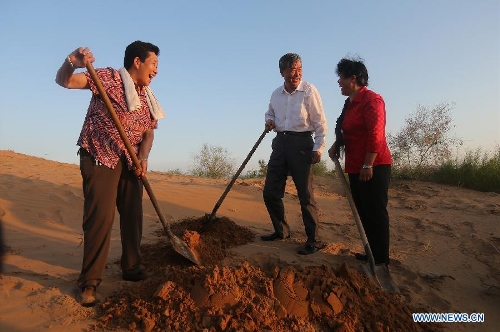
Li Congjun (C), president of Xinhua News Agency, plants trees with local planters Yin Shuzhen (R) and Niu Yuqin at the Mu Us Desert in Ordos City, north China's Inner Mongolia Autonomous Region, Aug. 12, 2013. China launched the Three-North Shelterbelt Forest Program in 1978 as an anti-desertification effort, which consists of forestation in northwest, north and northeast China. The latest State Forestry Administration (SFA) data showed that the forest coverage in the treated areas had increased to 12.4 percent at the end of 2012 from 5.05 percent in 1977. (Xinhua/Xing Guangli)

Tree planting volunteer Yi Jiefang holds a sandglass with inspirational words in Yinchuan City, capital of northwest China's Ningxia Hui Autonomous Region, Aug. 15, 2013. Yi, a woman devoting herself into voluntary tree planting, has planted about ten thousand mu (667 hectares) of forest in the past seven years. China launched the Three-North Shelterbelt Forest Program in 1978 as an anti-desertification effort, which consists of forestation in northwest, north and northeast China. The latest State Forestry Administration (SFA) data showed that the forest coverage in the treated areas had increased to 12.4 percent at the end of 2012 from 5.05 percent in 1977. (Xinhua/Xing Guangli)
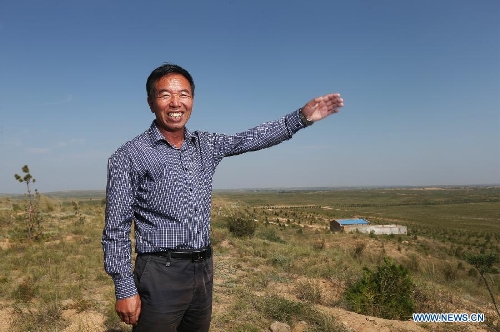
Photo taken on Aug. 13, 2013 shows local forestation pioneer Zhang Shengying in Yanchi County, northwest China's Ningxia Hui Autonomous Region. China launched the Three-North Shelterbelt Forest Program in 1978 as an anti-desertification effort, which consists of forestation in northwest, north and northeast China. The latest State Forestry Administration (SFA) data showed that the forest coverage in the treated areas had increased to 12.4 percent at the end of 2012 from 5.05 percent in 1977. (Xinhua/Xing Guangli)
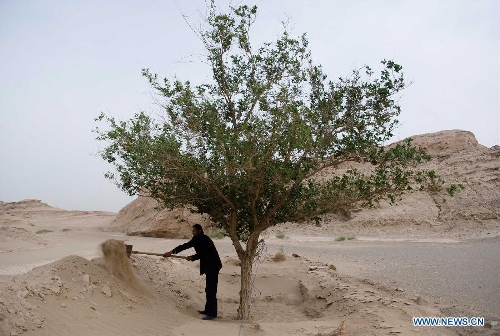
Rehman Amut, who has devoted to forestation for over 20 year, works on the wasteland where an elm tree grows, in Kuca County, northwest China's Xinjiang Uygur Autonomous Region, May 18, 2010. The elm is the only one survived among hundreds of trees he planted. China launched the Three-North Shelterbelt Forest Program in 1978 as an anti-desertification effort, which consists of forestation in northwest, north and northeast China. The latest State Forestry Administration (SFA) data showed that the forest coverage in the treated areas had increased to 12.4 percent at the end of 2012 from 5.05 percent in 1977. (Xinhua)
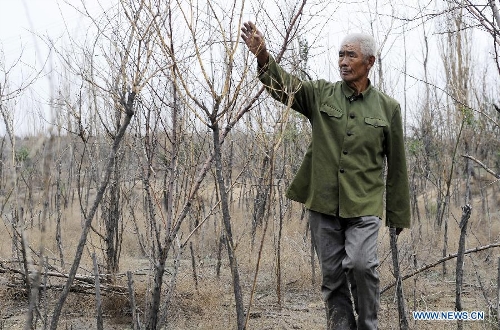
Local forestation pioneer Qiu Jiancheng checks the growth of trees at a shelterbelt forest in Shizuishan City, northwest China's Ningxia Hui Autonomous Region, Aug. 27, 2013. Qiu once owned a forest consisting of 110,000 trees, among which only 36 trees survived, due to the decline of groundwater. China launched the Three-North Shelterbelt Forest Program in 1978 as an anti-desertification effort, which consists of forestation in northwest, north and northeast China. The latest State Forestry Administration (SFA) data showed that the forest coverage in the treated areas had increased to 12.4 percent at the end of 2012 from 5.05 percent in 1977. (Xinhua/Li Ran)

Local forestation pioneer Zhang Yinglong tests the direction of wind at a desert in Shenmu County, Sept. 22, 2011. China launched the Three-North Shelterbelt Forest Program in 1978 as an anti-desertification effort, which consists of forestation in northwest, north and northeast China. The latest State Forestry Administration (SFA) data showed that the forest coverage in the treated areas had increased to 12.4 percent at the end of 2012 from 5.05 percent in 1977. (Xinhua/Chen Jianli)
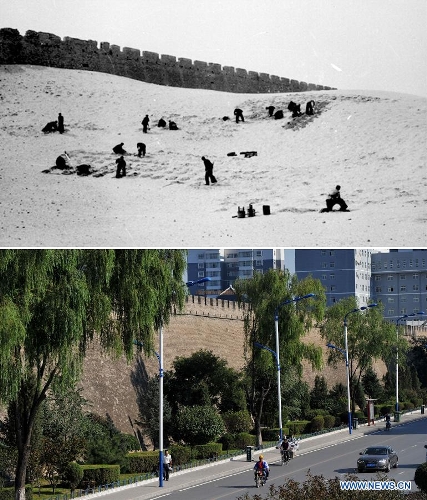
The combined photo shows the difference over years along the ancient city wall of Yulin City, north China's Shanxi Province. China launched the Three-North Shelterbelt Forest Program in 1978 as an anti-desertification effort, which consists of forestation in northwest, north and northeast China. The latest State Forestry Administration (SFA) data showed that the forest coverage in the treated areas had increased to 12.4 percent at the end of 2012 from 5.05 percent in 1977. (Xinhua/Liu Xiao)
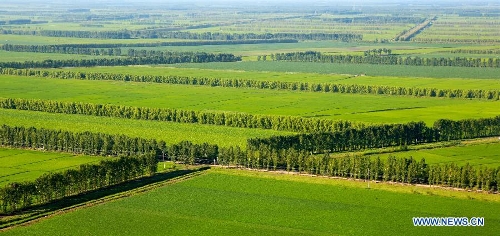
Photo taken on July 27, 2013 shows the shelterbelt forest at the Sanjiang Plain, northeast China's Heilongjiang Province. China launched the Three-North Shelterbelt Forest Program in 1978 as an anti-desertification effort, which consists of forestation in northwest, north and northeast China. The latest State Forestry Administration (SFA) data showed that the forest coverage in the treated areas had increased to 12.4 percent at the end of 2012 from 5.05 percent in 1977. (Xinhua)
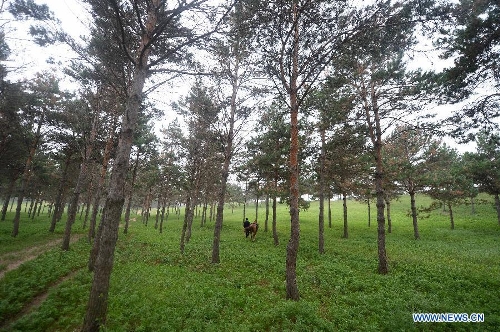
A forest ranger patrols in the the shelterbelt forest of Zhangwu County, northeast China's Liaoning Province, Aug. 3, 2013. China launched the Three-North Shelterbelt Forest Program in 1978 as an anti-desertification effort, which consists of forestation in northwest, north and northeast China. The latest State Forestry Administration (SFA) data showed that the forest coverage in the treated areas had increased to 12.4 percent at the end of 2012 from 5.05 percent in 1977. (Xinhua/Yang Qing)
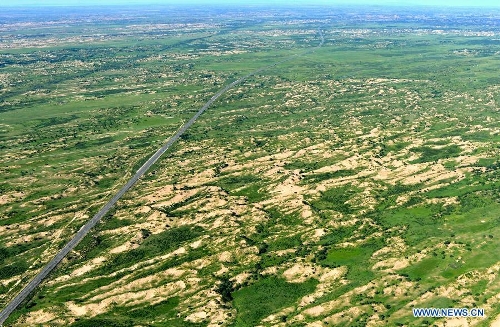
Photo taken on July 29, 2013 shows a road stretching through sands, in Xilingol League, north China's Inner Mongolia Autonomous Region. China launched the Three-North Shelterbelt Forest Program in 1978 as an anti-desertification effort, which consists of forestation in northwest, north and northeast China. The latest State Forestry Administration (SFA) data showed that the forest coverage in the treated areas had increased to 12.4 percent at the end of 2012 from 5.05 percent in 1977. (Xinhua)

Photo taken on Aug. 14, 2013 shows Wang Youde, head of the Baijitan tree farm, in Lingwu City, northwest China's Ningxia Hui Autonomous Region. Wang has devoted himself into forestation work for more than 20 years. China launched the Three-North Shelterbelt Forest Program in 1978 as an anti-desertification effort, which consists of forestation in northwest, north and northeast China. The latest State Forestry Administration (SFA) data showed that the forest coverage in the treated areas had increased to 12.4 percent at the end of 2012 from 5.05 percent in 1977. (Xinhua/Xing Guangli)
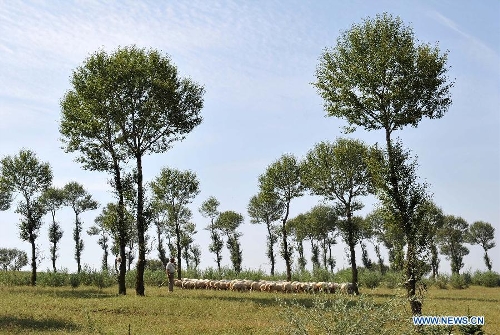
A shepherd herds sheep at a shelterbelt forest in Youyu County, northwest China's Shanxi Province, Aug. 26, 2013. China launched the Three-North Shelterbelt Forest Program in 1978 as an anti-desertification effort, which consists of forestation in northwest, north and northeast China. The latest State Forestry Administration (SFA) data showed that the forest coverage in the treated areas had increased to 12.4 percent at the end of 2012 from 5.05 percent in 1977.
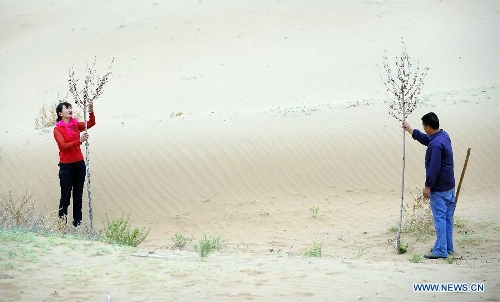
Local tree planter Gu Yunxiang (L) checks the trees with her husband Du Shenglong at the Mu Us Desert in Lingwu City, northwest China's Ningxia Hui Autonomous Region, June 17, 2011. China launched the Three-North Shelterbelt Forest Program in 1978 as an anti-desertification effort, which consists of forestation in northwest, north and northeast China. The latest State Forestry Administration (SFA) data showed that the forest coverage in the treated areas had increased to 12.4 percent at the end of 2012 from 5.05 percent in 1977. (Xinhua/Wang Peng)
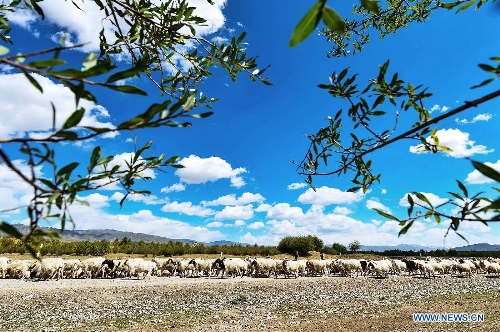
Shepherds herd sheep besides a shelterbelt forest at Senduo Town in Guinan County, northwest China's Qinghai Province, Sept. 11, 2013. China launched the Three-North Shelterbelt Forest Program in 1978 as an anti-desertification effort, which consists of forestation in northwest, north and northeast China. The latest State Forestry Administration (SFA) data showed that the forest coverage in the treated areas had increased to 12.4 percent at the end of 2012 from 5.05 percent in 1977. (Xinhua/Wu Gang)
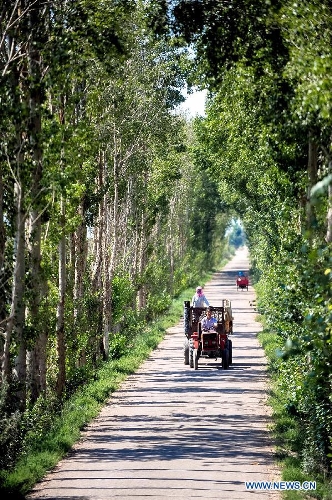
Villagers drive vehicles through a shelterbelt forest in Datan Township of Minqin County, northwest China's Gansu Province, Sept. 6, 2013. China launched the Three-North Shelterbelt Forest Program in 1978 as an anti-desertification effort, which consists of forestation in northwest, north and northeast China. The latest State Forestry Administration (SFA) data showed that the forest coverage in the treated areas had increased to 12.4 percent at the end of 2012 from 5.05 percent in 1977. (Xinhua/Zheng Meng)